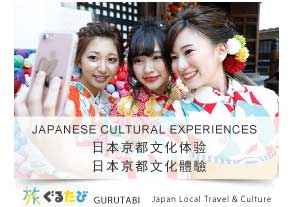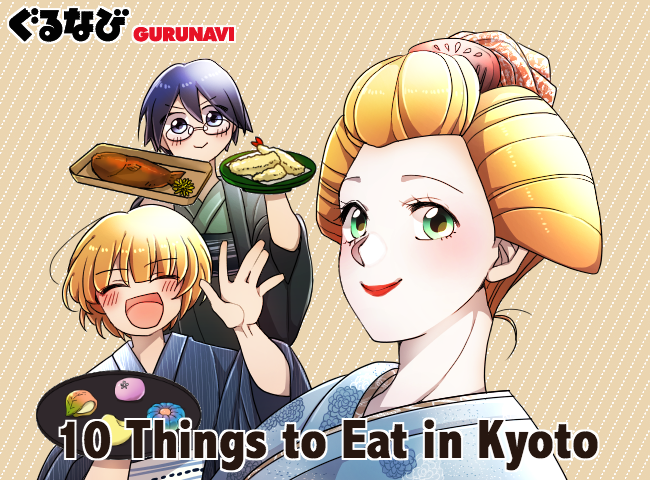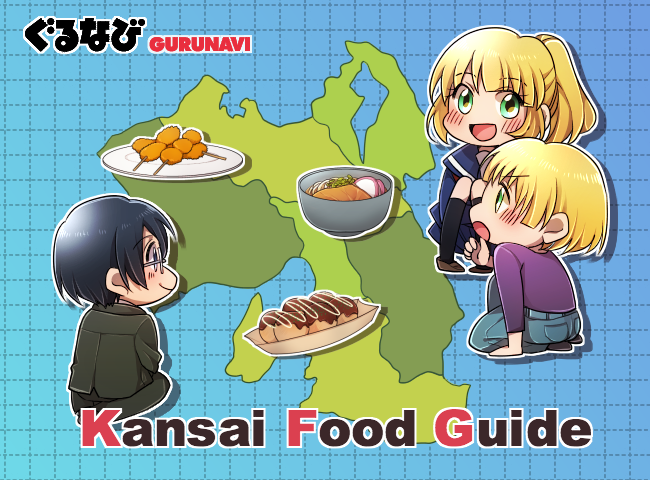Summary of the Region
Kyoto is one of the top sightseeing spots in Japan.
 The city of Kyoto is located slightly west of central Japan and is a city with a long history. Kyoto is surrounded by mountains, making its winters very cold and summers very hot. Many rivers, both large and small, flow through the region, the most important of which is the Kamo River. The physical characteristics of the region have heavily influenced the nature, culture, and development of the Kyoto area. The four seasons play an important role in Kyoto and the cultures, such as art, architecture, and literature, it has spawned.
The city of Kyoto is located slightly west of central Japan and is a city with a long history. Kyoto is surrounded by mountains, making its winters very cold and summers very hot. Many rivers, both large and small, flow through the region, the most important of which is the Kamo River. The physical characteristics of the region have heavily influenced the nature, culture, and development of the Kyoto area. The four seasons play an important role in Kyoto and the cultures, such as art, architecture, and literature, it has spawned.
History of Kyoto
 Kyoto was made the capital of Japan in 794. The streets in central Kyoto were laid out in a grid-like pattern, a layout that supposedly was borrowed from the city of Chang'an, the capital of China at the time. The capital was later moved to Tokyo, but only after over 1000 years of Kyoto being the cultural center of Japan. Surrounded by nature, Kyoto has given birth to innumerable cultural contributions. It has also survived numerous wars and rebellions and even now many very old structures still stand in Kyoto. In general, the natural flavors and aromas of ingredients are important in Kyoto cuisine, and extra seasonings are kept at a minimum. Sweet white miso paste is also used instead of normal miso.
Kyoto was made the capital of Japan in 794. The streets in central Kyoto were laid out in a grid-like pattern, a layout that supposedly was borrowed from the city of Chang'an, the capital of China at the time. The capital was later moved to Tokyo, but only after over 1000 years of Kyoto being the cultural center of Japan. Surrounded by nature, Kyoto has given birth to innumerable cultural contributions. It has also survived numerous wars and rebellions and even now many very old structures still stand in Kyoto. In general, the natural flavors and aromas of ingredients are important in Kyoto cuisine, and extra seasonings are kept at a minimum. Sweet white miso paste is also used instead of normal miso.
Highlights
The Four Seasons of Kyoto
 Spring: Since ages long ago, the Japanese people have always loved "sakura," the Japanese name for cherry blossoms. Hanami, the custom of viewing and appreciating sakura, is very important in Japan. Kyoto boasts a number of excellent sakura viewing spots within the walls of its many temples and shrines, as well as elsewhere throughout the city.
Spring: Since ages long ago, the Japanese people have always loved "sakura," the Japanese name for cherry blossoms. Hanami, the custom of viewing and appreciating sakura, is very important in Japan. Kyoto boasts a number of excellent sakura viewing spots within the walls of its many temples and shrines, as well as elsewhere throughout the city.
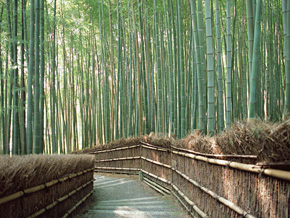 Summer: Kyoto summers are hot and humid, so many people find them difficult to tolerate. Kyoto offers numerous unique methods to beat the heat. One of these is the "noryo-yuka" or "kawadoko," where restaurants set up seating next to, or even on top of, a river. The water evaporating from the river cools off thesurrounding area and makes for a refreshing Summer dining experience. Additionally, the most famous festival in Kyoto, the Gion Matsuri, is held in summer and spans the entire month of July.
Summer: Kyoto summers are hot and humid, so many people find them difficult to tolerate. Kyoto offers numerous unique methods to beat the heat. One of these is the "noryo-yuka" or "kawadoko," where restaurants set up seating next to, or even on top of, a river. The water evaporating from the river cools off thesurrounding area and makes for a refreshing Summer dining experience. Additionally, the most famous festival in Kyoto, the Gion Matsuri, is held in summer and spans the entire month of July.
 Autumn: Autumn is the most popular season for tourists in Kyoto. The mountain landscapes and temple grounds are awash in autumnal reds, yellows, and oranges as the leaves change and show Kyoto at its best.
Autumn: Autumn is the most popular season for tourists in Kyoto. The mountain landscapes and temple grounds are awash in autumnal reds, yellows, and oranges as the leaves change and show Kyoto at its best.
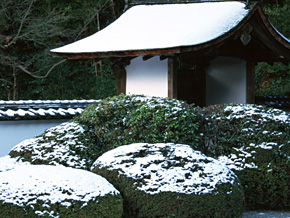 Winter: Tourists are relatively few in number come winter, which means winter is a good time for relaxed sightseeing. Kyoto blanketed in snow is also a sight to behold. Gazing at the cold Kyoto landscape over a hot tofu stew is a wonderful way to spend the winter.
Winter: Tourists are relatively few in number come winter, which means winter is a good time for relaxed sightseeing. Kyoto blanketed in snow is also a sight to behold. Gazing at the cold Kyoto landscape over a hot tofu stew is a wonderful way to spend the winter.
Maiko and Geigi
 Walking through Kyoto, you might see young women wearing kimono with their faces painted white and wearing deep red lipstick. These young women are either "geigi" or "maiko." Geigi are female entertainers who entertain their guests with dance, song, and music. Maiko are apprentice geigi. Services that let you rent kimono and wigs to dress up like maiko are very popular.
Walking through Kyoto, you might see young women wearing kimono with their faces painted white and wearing deep red lipstick. These young women are either "geigi" or "maiko." Geigi are female entertainers who entertain their guests with dance, song, and music. Maiko are apprentice geigi. Services that let you rent kimono and wigs to dress up like maiko are very popular.
Kyoto Food
Here are some characteristics of Kyoto food, as well as some commonly eaten ingredients and dishes.
Finding Asian Restaurants
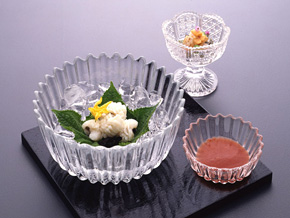 Kyoto was for a long time the cultural center of Japan. Kyoto's food culture developed thus developed along with its history. Because central Kyoto is far from the sea, people in Kyoto had a difficult time obtaining fresh seafood. They focused instead on using the ingredients that were readily available to make dishes as delicious as possible, while developing new preparation techniques along the way.
Kyoto was for a long time the cultural center of Japan. Kyoto's food culture developed thus developed along with its history. Because central Kyoto is far from the sea, people in Kyoto had a difficult time obtaining fresh seafood. They focused instead on using the ingredients that were readily available to make dishes as delicious as possible, while developing new preparation techniques along the way.
In general, the natural flavors and aromas of ingredients are important in Kyoto cuisine, and extra seasonings are kept at a minimum. Sweet white miso paste is also used instead of normal miso.
Kyo-yasai
Traditional vegetables cultivated in the fertile soils and rich waters of Kyoto. These are some of typical Kyo-yasai vegetables.
 |
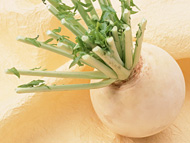 |
| Kamo nasu:Large, spherical eggplant. Famous "nasu dengaku," which is miso spread on eggplant and grilled. | Shogoin kabu (turnip): Used in salads and a type of Kyo-tsukemono called "senmai-zuke." |
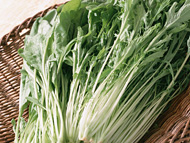 |
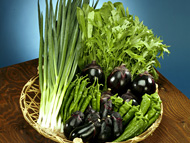 |
| Mizuna (Japanese mustard greens): Has a crunchy texture. Used in salads, as a topping, in hot pots, etc. | Kujo negi: A tender and sweet green onion, used to make "nuta" when mixed with miso and other ingredients, and also used in hot pots. |
| Shogoin daikon (Japanese radish): Large, spherical daikon. Sweet. |
Obanzai
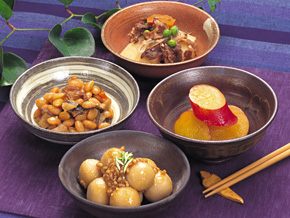 Everyday foods are called "obanzai" in Kyoto. These are some typical obanzai.
Everyday foods are called "obanzai" in Kyoto. These are some typical obanzai.
| Chirimen sansho: Very small fish called "chirimen jako" and spicy "sansho" are seasoned with soy sauce. | Nishin no kombu-maki: Pacific herring wrapped in kombu seaweed and stewed. |
| Imobo: Dried cod called "bodara" stewed with a kind of potato called "ebi imo." |
Tofu and Yuba
 Tofu is made pressing soy beans and hardening the extracted liquid. Yuba is the film that develops on top of the extracted liquid when it is heated. Tofu and yuba are eaten often in Kyoto.
Tofu is made pressing soy beans and hardening the extracted liquid. Yuba is the film that develops on top of the extracted liquid when it is heated. Tofu and yuba are eaten often in Kyoto.
| Yu-dofu:Tofu heated in a pot of kombu seaweed stock. Tofu is topped with sauce and eaten. Condiments include green onions, momiji oroshi (grated daikon and chili pepper), and yuzu (a kind of citrus fruit). | Kumi-dofu: Tofu is usually pressed into blocks, but kumi-dofu is soft tofu prior to being pressed. |
| Kumiage-yuba: Yuba has a creamy texture. Here it is eaten with wasabi and soy sauce. | Tofu dengaku:Tofu is skewered, covered with miso sauce, and grilled. |
Kaiseki Ryori
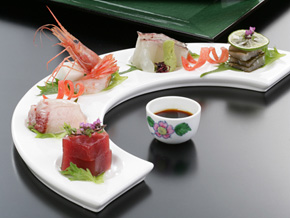 Kaiseki ryori is a style of cuisine based on foods used in cha-no-yu, the art encompassing the aesthetics, techniques, and thinking related to the Japanese tea ceremony. Kaiseki is a course meal where items are served one at a time. Kaiseki can be eaten at traditional Japanese ryotei restaurants or kaiseki restaurants. Only the finest ingredients are used in the preparation of the meal, and service is almost always excellent, making kaiseki ryori an expensive dining experience.
Kaiseki ryori is a style of cuisine based on foods used in cha-no-yu, the art encompassing the aesthetics, techniques, and thinking related to the Japanese tea ceremony. Kaiseki is a course meal where items are served one at a time. Kaiseki can be eaten at traditional Japanese ryotei restaurants or kaiseki restaurants. Only the finest ingredients are used in the preparation of the meal, and service is almost always excellent, making kaiseki ryori an expensive dining experience.
If you're on a budget but would like to try kaiseki, try a "shokado bento" or a short kaiseki course called a "mini-kaiseki." The bento is served in a "jubako," a square lacquered box.
Kyo-Tsukemono
 Tsukemono (various kinds of pickles) are famous in Kyoto. Tsukemono are made by putting vegetables in vinegar and salt, then storing them with a weight on top to keep out air until the pickling is finished. Tsukemono can be kept for a long time.
Tsukemono (various kinds of pickles) are famous in Kyoto. Tsukemono are made by putting vegetables in vinegar and salt, then storing them with a weight on top to keep out air until the pickling is finished. Tsukemono can be kept for a long time.
| Suguki: Sugukina, a kind of turnip, is pickled in salt and fermented. | Senmai-zuke: Pickles made from thinly-sliced shogoin kabu turnip, which is picked with salt and then seasoned. |
| Shiba-zuke: Thinly-sliced eggplant and shiso leaves pickled in salt. |



